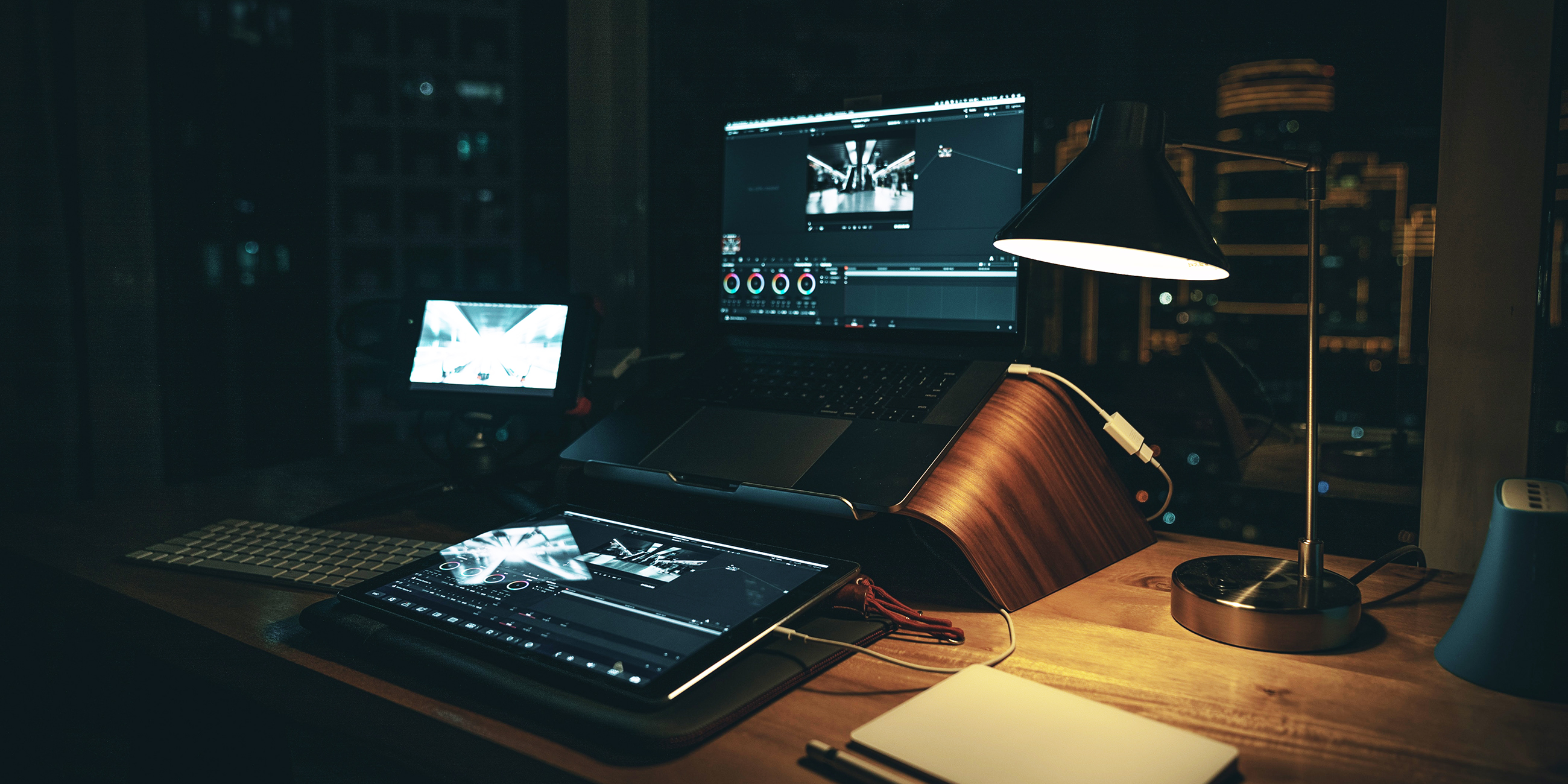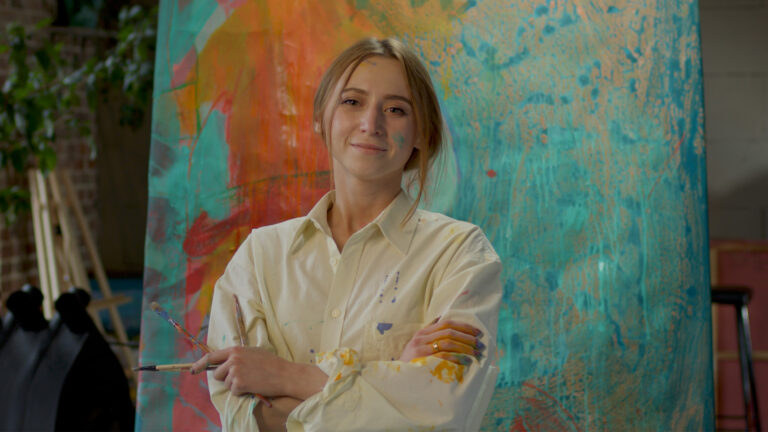As we’ve all learned in the last several weeks, remote post-production presents a huge opportunity to refine our workflows and sharpen our creative skills.
But just like with editing at home, there are some things we need to know before we can successfully color grade from the comfort of our home office (or living room or kitchen).
There are the obvious technical hurdles to overcome once you step outside your facility, like bandwidth and storage. And, of course, we’ll have to relearn a few efficiency/productivity skills when we’re working without our team around us.
But the much trickier part of grading from home is discovering how to effectively collaborate on the look of the project.
A successful grade needs to satisfy the client’s creative vision, convince them the project feels right, and reassure them that it is the best face for their story. And when we’re grading at home, outside our comfortable DI theaters and high-end review setups, we have to do all that without ever physically being in the room with them.
I’ve spent more than a decade investigating the tools and workflows needed to create this kind of collaborative, remote color grading workflow. Since 2007, I’ve been cultivating the habits and techniques to make the experience more rewarding, productive, and creative for everyone involved.
So let’s dive in.
Tentpoles and benchmarks
The first key step in the remote grading process should be familiar to most colorists: break the project down into benchmarks and tentpoles.
Tentpoles are the key shots that establish the look and feel of a project, and around which you base your color decisions.
Benchmarks are the steps and decisions you’ll need to successfully move through the whole project, including expectations from both sides.
Deciding on these shots and processes is the earliest part of the collaborative relationship between you and the client, DP, director, or producer, so feel free to be as creative as possible.
You don’t need to limit yourself artificially. Set wide boundaries as you explore with the client, and then refine as you go.
As colorists, we have a pretty wide palette of looks to choose from. We can go darker, or brighter, or colder, or warmer, or high or low contrast, or a billion shades in between. There are a lot of options, and there isn’t a “right” answer.
The only thing you need to be concerned with is “what look best serves the purposes of the project?” That’s something you will discover as you collaborate with the client.
And that’s why Tentpoles and Benchmarks are so important. You want to avoid taking a whole pass on the entire project, all in the wrong direction. You need to orient yourself first.
I usually watch the whole project beginning to end, and then discuss particular moments with the client (often in Frame.io) to decide what the tentpole shots and sequences are.
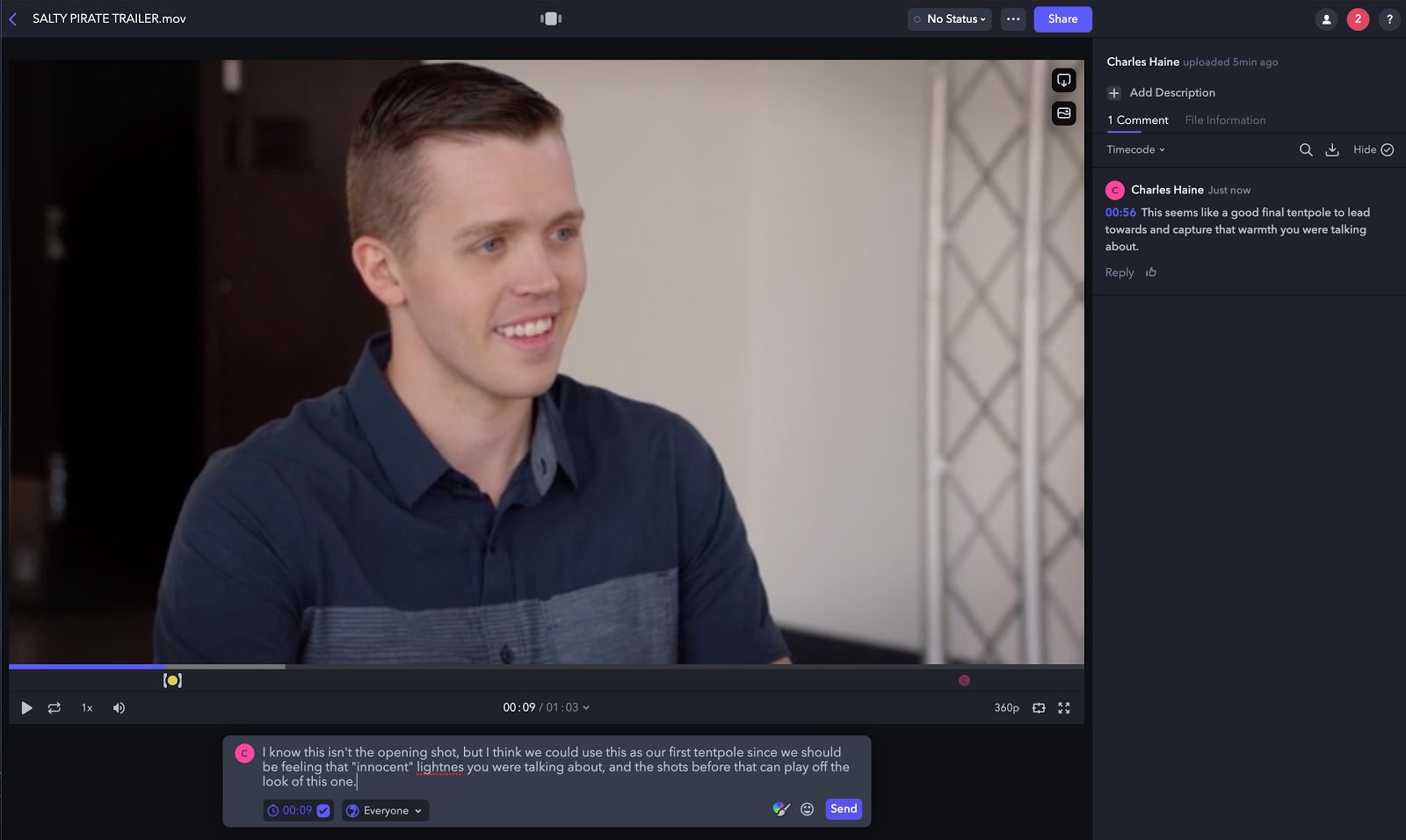
I usually like to choose tentpoles in the exposition, a shot from the climax, and a shot near the midpoint. If possible, pick 2-3 shots from each sequence as a tentpole.
On top of these tentpoles, identify with the client if there are any special looks required. Flashbacks, flash forwards, fantasy sequences, dream sequences, or anything that will get it’s own special treatment. These will usually fall outside the tentpole looks, and will require extra work.
Once you have your tentpoles, you can start to lay out benchmarks.
I like to talk through each tentpole with the client for a few minutes, and let them tell me (as best as they can) what they want it to look like. There will, of course, be considerable revisions on the final look of the tentpoles, but these initial conversations are very important. This is the time to explore as wide a field as possible.
Even looks that don’t seem immediately like the right fit can be helpful, as they help you eliminate options, and prove to the client they aren’t “leaving anything on the table.”
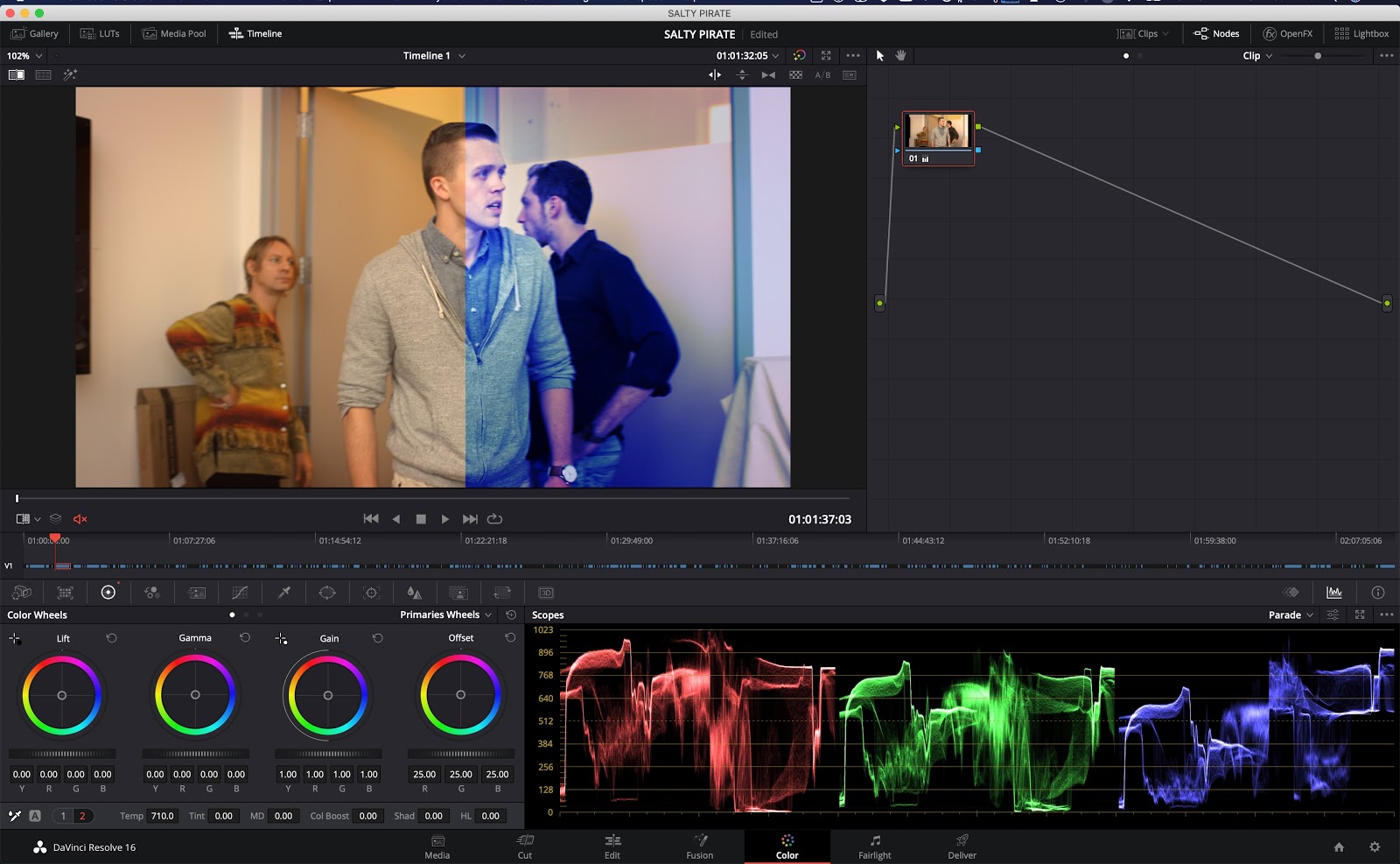
I say “considerable” revisions, but in my experience it’s rare to go past 5-10 rounds of revisions. The more detailed the feedback you can get from the client, and the better you listen, the easier it will be to find the look that best fits the project.
Clear Communication
Once you and the client have “locked” the look of the tentpoles (which should only be around 8-10 shots total), then we can expand these creative choices onto the whole.
I generally limit a full pass to three rounds of notes and revision. To avoid an infinite cycle of notes and fixes, be sure to establish time boundaries at the beginning of the project.
If the client knows they only get three sets of notes, they will focus more on their feedback, think more carefully about revisions, and be selective about “quick tweaks.”
I also make it clear I need one group of notes from all the people reviewing (director, producer, DP, head of marketing, etc.). Those need to be collated together into a single document for each round of notes.
While I request “internally coherent” notes, meaning that the client’s team need to work agree on revision before sending notes to me, I also make it clear that I’m happy to be involved in creative conversations to help solve conflicts and explore solutions.
For instance, I’ve had notes on the same shot that it was “too light” and “too dark” at the same time. This might seem odd, until you realize who sent in the notes: the DP thought it was too light, and the director too dark.
In my experience, DPs are more concerned with the mood of the whole shot, while the director is looking at the actor’s performance more carefully. By making the edges darker, you can often push the mood dark enough for the DP, and then use a tracking mask on the character to brighten the face enough for the director to see the performance.
So, by combining tools, both the DP and the director get what they want from seemingly conflicting notes. A shot can be both “darker” and “lighter” at the same time. You just need to talk through each person’s notes to hone in on what they want.
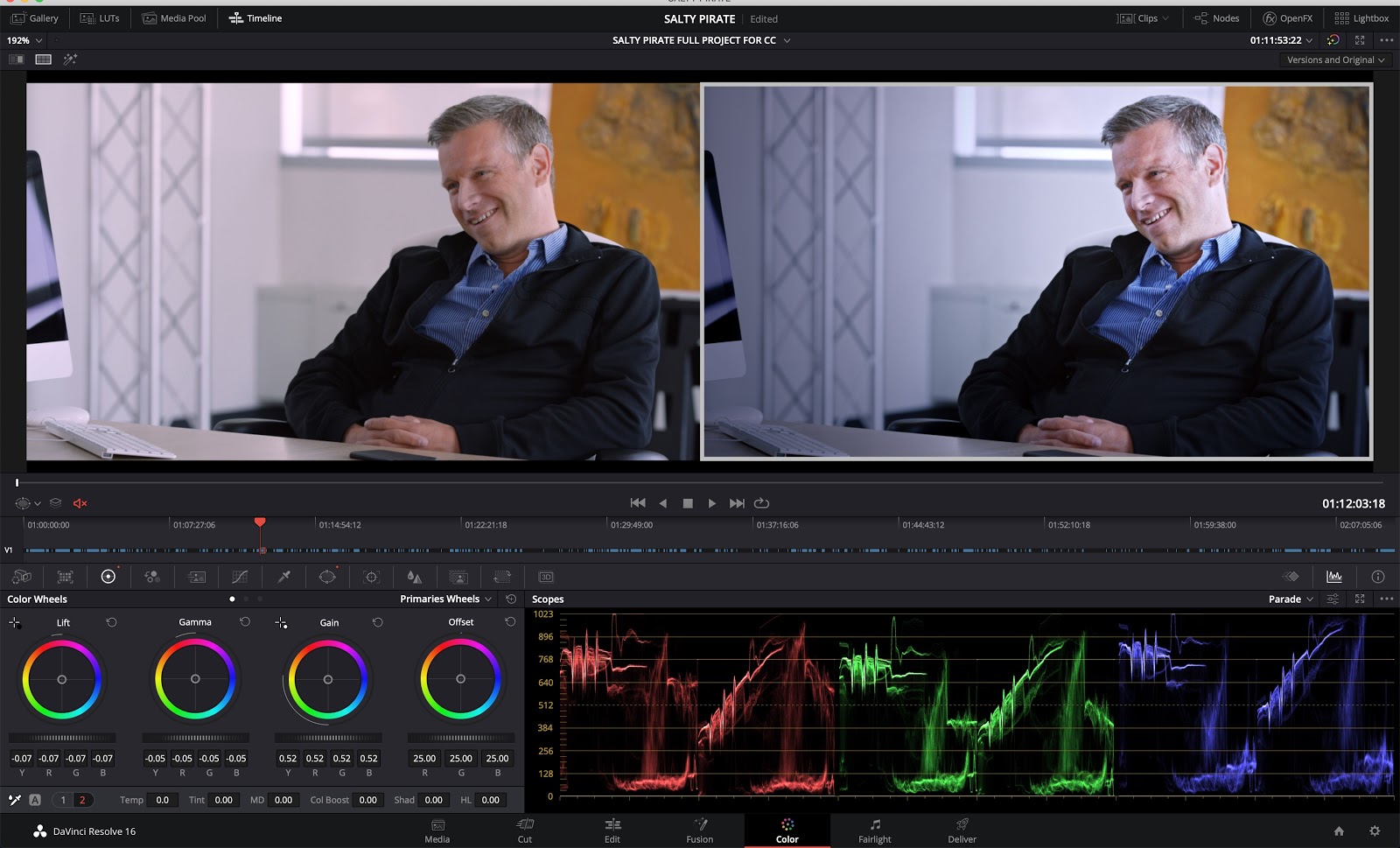
But sometimes there are major conflicts, like when a director wants a big, sunny, saturated musical feeling and a DP wants a horror film. This ideally should have been hashed out in pre-production, and frankly aren’t something you can fix in post.
Learning to navigate these situations takes a lot of over-communication, and the expectation that you will likely leave at least one of the team members unsatisfied.
This is yet another reason why tentpole looks are so vital, especially when you are grading remote. They can help you identify these types of issues in creative vision before you spend hours grading the whole film. Be sure that everyone with creative authority on the project is in the loop and leaving feedback during this stage of the grade.
Timelines
One key point to emphasize at every step in the process is that there are realistic time expectations on both sides.
I’m always clear about how long a specific tweak or change will take me, using phrases like “I need 10 days for this, but will deliver it to you sooner if possible.” But I’m also very clear about how long they have to give notes. “You’ll then have 72 hours to review the project for notes.”
Clearly stating this time requirements is tremendously important, since clients usually have to wrangle multiple people for review and approval. And since you will all be working asynchronously, it’s doubly important to get them moving early.
If all of those stakeholders are managing multiple projects, as they often are, you don’t want yours falling through the cracks. If they regularly take two weeks to give notes, projects can very quickly balloon to 2-month-long slogs.
Notes that would’ve been easy to interpret 3 days after a grade, while your memory of your work is fresh, are much harder to interpret 3 weeks later when you are trying to remind yourself of how and why you did something a certain way.
This is especially true for “tricky” shots. Some shots are just harder to color than others, and you have to try a variety of tricks and hacks to get it looking pleasant and well-matched.
If I get notes on a tricky shot quickly, I’ll remember all the work I did on it, and be able start on it again more easily. But if it’s been 2 weeks, I might waste an hour pushing the shot around again trying to re-learn the same issues from before.
With remote grading, you want your work fresh on your mind, and clients notes as quickly as possible.
Stills vs. Motion
Even today many clients still want to do a lot of their approvals with still images instead of motion.
This is partially understandable, since it’s faster to send them a still image than it is a video file, and some less-tech-savvy users find stills easier.
But while stills can be useful for early communication of identifying the tentpole shots, it’s critical you move to motion pictures as soon as you can, especially when choosing tentpoles.
Grades look different in still and in motion. A shot might look too dark in a still (“I can’t even see their face” the client might say), but then in motion you see that you are drawn to the face by its movement, and it makes sense that it’s a little dark.
You might see that the character walks out of a pool of darkness into light, so you want it darker earlier in the shot and bright toward the end. There are countless ways that motion helps the creative process, so use it.
I usually make a reel of just the tentpole shots, and give that to clients to watch in a loop over and over again before they leave notes. This helps them get used to the scenes we’re talking about, so they can better notice subtle changes in the grade.
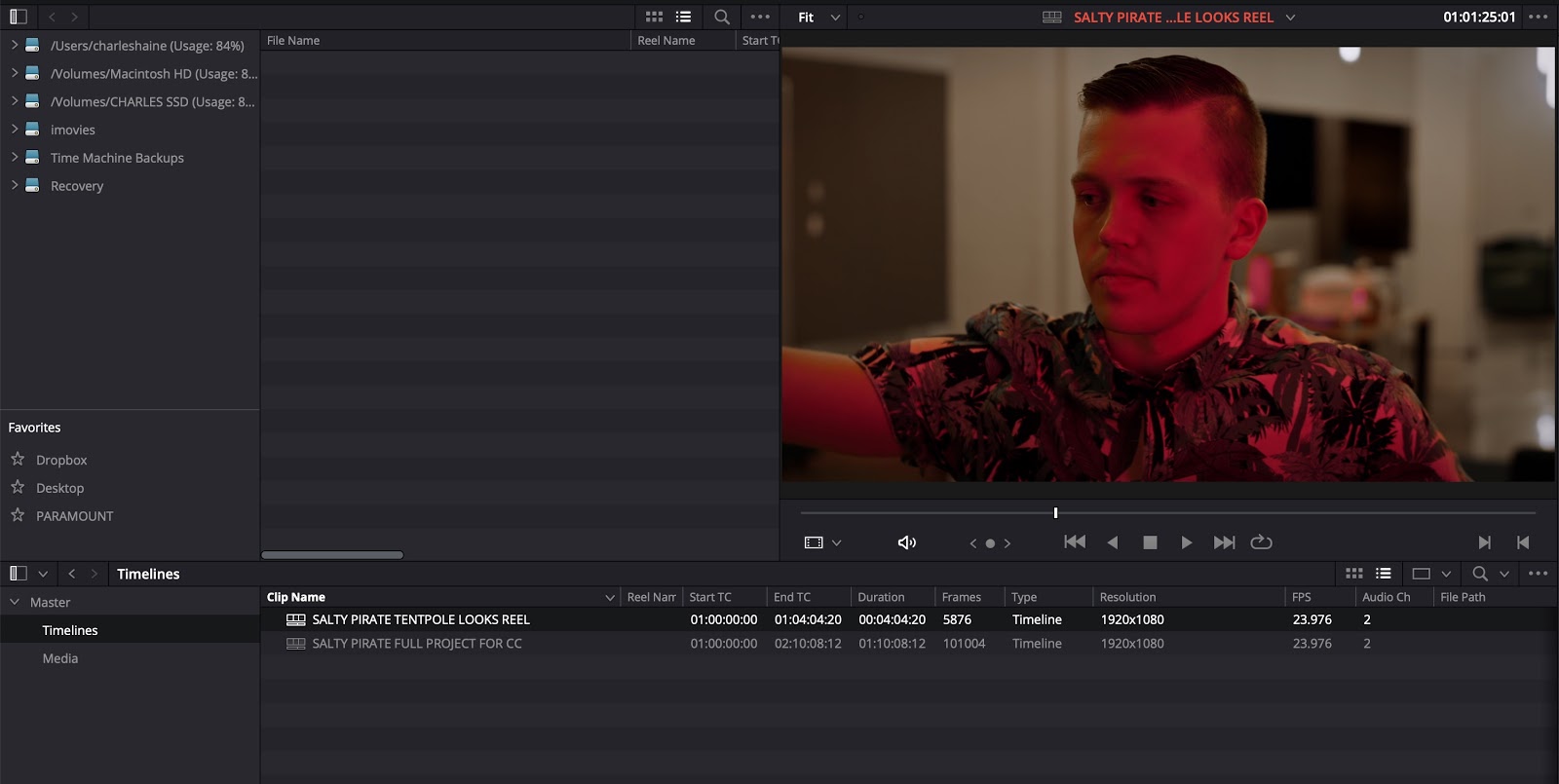
Especially now that remote video tools (like Frame.io) offer timecode-based notes, along with on-screen annotations, clients can leave even more specific notes than they would if they were in the suite with you.
So to reiterate, don’t use stills for client review of your grades.
Evaluating the image
One of the frustrations some have with remote grading is the difference between a grading suite and a client’s office.
This issue is one filmmakers have dealt with for years. I’ve spent many hours grading a shot in a fancy grading suite, only to have the client watch it on a laptop and leave nonsensical notes about the look. It’s a problem that leads to frustration most of us have learned to live with.
But remote workflows (and the miracle of modern technology) are starting to alleviate this pain point.
It’s no secret that the iPad Pro has a pretty great screen. It’s bright, consistent, and, most importantly, lots of clients already use them in their daily workflows.
This gives you unique insight into the viewing accuracy and device capabilities on the client’s end, and allows you to compensate. Once you’ve completed your grade on your studio-quality display, pull up the sequence on an iPad pro. Compare the image between the two displays, and indicate any disparities in your notes. That will help you anticipate the client’s viewing experience and translate their notes accordingly.
And if you use a native iPad review app, you’ll avoid the typical color cast issues you run into with browsers. Not to mention, you’ll maintain a consistent review experience for the client across devices.
The iPad Pro has reasonably accurate and predictable color response, if you turn off the “auto-brightness” settings that try to calibrate the image to the lighting environment around it.
There are other solutions that attempt real-time view on the iPad Pro while you are grading, but those will have the same software issues we talked about before.
Using Sidecar or setting it up as a pure video device will show you what the screen looks like, but not how the software will process it. The best practice remains to make an export and view it in the same app the client will use. That way you’ll see the grade in the same way.
Some colorists like to “chase” various home viewing environments and do a series of outputs to a variety of different release platforms, but I think there are too many different platforms and viewing contexts to realistically explore them all.
When it comes to your remote grading workflow, you should still focus on making your image look as good as possible on a calibrated broadcast monitor. Once you’ve done that, make technical tweaks that help the client convey their creative vision accurately. But at the end of the day, trust your highest-quality screen, and leave the rest of the innumerable possibilities behind.
Billing
An important business process to reevaluate when grading remote is how you price your work.
In-person real-time color grading has traditionally been billed by the hour. But clients often don’t want to pay by the hour when they can’t “see” the hours that someone works on something. And honestly, as a colorist who’s been doing this for years, I don’t think billing by the hour makes the most sense for some remote jobs.
Unfortunately, keeping track of your time can be a hassle. Especially for short gigs you squeeze in around other larger clients, recording every little time block can be more work than the grade itself. So you might think a flat rate is a good idea.
However, before committing to anything resembling a flat rate for a remote job, it’s vital to watch the work first and set boundaries around what that rate includes.
Watching the work is vital, as different projects require different amounts of time. Obviously, An action feature that was shot on 5 different cameras, and with 3000 edits, including a flashback and flash-forward will take more time than a simple indie drama shot on a single camera with only 500 cuts.
Never agree to anything like a flat or buyout rate without watching the work and thoroughly discussing the director’s vision.
In terms of boundaries, as discussed above, setting time boundaries is hugely important. You need to make sure you’re being compensated for how long the overall work will take, the deadlines you’re expected to meet, and the number of revisions you have to produce.
Setting those deadlines is critical to establishing a sufficient rate. The client might have a festival they are hoping to hit, but you might have a huge job looming around that same time. It’s alright to say “I’m agreeing to a flat rate, but the project has to be done by X date; anything after that bills normally.”
Your boundaries and billing should also include deliverables. Many color clients are used to facilities creating a whole host of deliverables. So when you’re working with a remote client, make sure they understand how much a web deliverable vs a DCP costs, and how much extra time producing all the different formats (clean cuts, different languages, and exports without titles) will take.
Setting those expectations from the beginning, and in writing, will allow you to account for your time properly, and bill the client accurately. If you agree to deliver more than one format, you need to plan time to do so.
Saving time on revisions and deliverables
After you’ve rendered an entire feature, which can take hours at large resolutions, it can be frustrating to have to tweak one or two small shots that will require re-rendering the whole project.
But here’s my recommendation to save you huge amounts of time when the client inevitably asks for a change. There is an amazing tool called CineXTools that allows you to insert edit into a quicktime video, without re-rendering the whole sequence.
So, if you have a 4K ProRes feature that took 4 hours to render, but the client wants to tweak one, two-second shot in the middle, you can use CineXInsert to insert edit that shot into the middle of the feature in a few seconds, rather than many hours.
Be flexible
The last thing to consider in your remote grading workflow is to be a little flexible, especially as projects wrap up.
As I recommended above, I usually stick to three rounds of notes for a client. But many of us are still getting used to remote workflows and the changes in the industry, so if a week after wrap someone asks for a very small tweak, it’s often worth doing it.
Remote jobs are more complicated in terms of client relationships. You don’t get to spend hours in the suite together talking about sports or life or kids or whatever you like. So every little chance you get to enrich that relationship is a boost to the possibility of repeat business or a client recommendation.
And that extends to the more “everyday” parts of your workflow. Be a little extra friendly in email, slack, and phone calls, and use the tools available to display emotion and tone (maybe emojis if appropriate). Flexibility and personability go a long way with remote work.
The goal is always for both sides to walk away feeling like they have fruitfully collaborated. Remote workflows are no different. So put your best foot forward.

